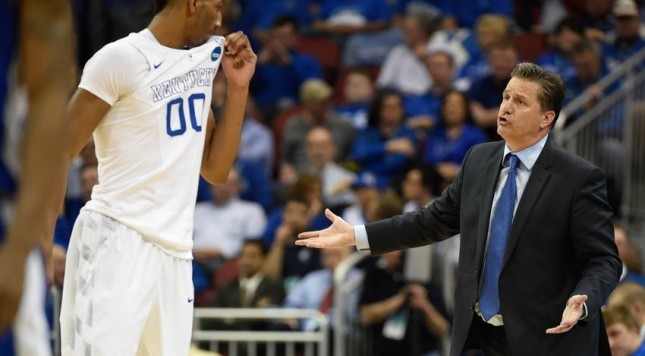We’ll have more to say on the victorious Indiana Hoosiers on Monday, as we look ahead to the Sweet 16 and North Carolina, but let’s first deal with the Kentucky Wildcats, out of the NCAA tournament earlier than most expected.
The Wildcats fell to Indiana on Saturday in Des Moines, failing to make the second weekend of the Big Dance. Big Blue Nation was hoping that this team could re-create the run to the 2011 Final Four, but in order for that to happen, a backcourt-dominant team needed prime performances in the paint.
The Cats pawed and pried and poked in their search for answers, but John Calipari found a paucity of production in the low post. Alex Poythress and Marcus Lee came up empty against the Hoosiers, and that — plus Jamal Murray’s poor decisions with the ball in open-court situations, especially in the second half — didn’t cut it against a cohesive and flatly superior Indiana team which moved the ball better and generated quality shots down the stretch.
*
Remember this guy, and how much gosh-darn FUN he had in sparking Kentucky to a surprising 2011 Final Four run, the first for Calipari in Lexington?
The year after Brian Zoubek came alive in the NCAA tournament to power Duke to an unexpected national title, Josh Harrellson nearly became the same thing for Kentucky. Big Blue didn’t win it all, but Kentucky’s ability to make the Final Four as a 4 seed in the East Region — beating No. 1 Ohio State and No. 2 North Carolina on the second weekend of the tournament — made that 2011 campaign a success. It restored the right tone and trajectory for the Calipari era. The next year, Cal finally won his first national championship as a head coach, joining the other iconic coaches to win a national title at Kentucky (plus Tubby Smith).
That 2011 Kentucky team was its own entity, but on a very general and broad level, it was not terrifically different from this 2016 team in that it got most of its work done in the backcourt and on the wings — you can see for yourself. Entering the 2011 NCAA Tournament, Kentucky needed help in the paint, and Harrellson filled that void, stepping into the forefront to help out Brandon Knight and Doron Lamb. That team’s perimeter players still carried most of the workload, but unless you’re a generationally unique and significant college basketball player such as Carmelo Anthony or Danny Manning — someone who can truly carry a team on his back throughout the Dance — a roster generally needs timely help and balanced contributions at some points in an NCAA tournament journey. More precisely, role players can’t just be the recipients of a teammate’s passes or the beneficiaries of double-teams on the star scorer (as was the case for Manning, Melo, and a handful of other special players who were one-man wrecking crews in March). They have to put in their own work — on defense, on the glass, and shooting the three-pointer the defense dares them to hit.
Harrellson did these things against Ohio State and North Carolina in that NCAA tournament — enough, at least, to remove some of the burden from the rest of the Kentucky roster. The Wildcats used that X-factor addition to make the Final Four and set the Calipari era on the right course.
This year’s No. 4 seed needed the same basic contributions from Marcus Lee and Alex Poythress. In a program of one-and-dones, Lee and Poythress are exceptions and not the rule. Lee never acquired the full skill set of a player who could jump early to the NBA, and Poythress was frequently dogged by injuries in a snake-bitten college career. Nevertheless, the point was plain entering Saturday’s encounter with Indiana: Jamal Murray and Tyler Ulis needed help.
They didn’t get it.
Remember Marcus Lee’s dunkfest in the 2014 NCAA Tournament, especially the regional final against Michigan?
That’s the Marcus Lee Kentucky and Calipari had to see on Saturday. Thomas Bryant and the rest of Indiana’s bigs didn’t have much trouble in keeping Lee quiet. The same was true for Poythress, who at times in the second half had Yogi Ferrell — of all people — guarding him within 10 feet of the rim… and meekly passed the ball to the perimeter instead of backing down a much smaller and weaker man.
As stated above, Murray — who profoundly struggled in this game — didn’t make good decisions with the ball. Kentucky hunted threes when it likely would have scored twos. Accumulated decisions cost the Wildcats points throughout the game, and that certainly played a role in shaping the final outcome. Yet, the biggest reason Kentucky fell short of its hopes and goals during the regular season was the same reason the Cats couldn’t return to the Sweet 16: With Skal Labissiere more of a long-term project than an instant force, the veteran bigs on the roster needed to recall past Kentucky conquests in the NCAA tournament… especially when the Wildcats weren’t a No. 1 seed.
The fourth-seeded team in 2011 had Josh Harrellson.
The eighth-seeded team in 2014 had a much more effective and energized Marcus Lee.
This team came up empty.
Jamal Murray, a freshman, just had one of those days. It happens. Marcus Lee and Alex Poythress didn’t merely have “one of those days.” Two familiar faces in the NCAA tournament knew they had to help out their younger teammates against an opponent without an imposing frontcourt. That they failed is what will linger from this season, and especially this year’s NCAA tournament exit for Kentucky.


